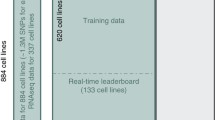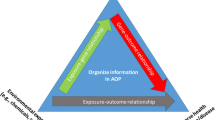Abstract
Characterizing population variability, including identifying susceptible populations and quantifying their increased susceptibility, is an important aspect of chemical risk assessment, but one that is challenging with traditional experimental models and risk assessment methods. New models and methods to address population variability can be used to advance the human health assessments of chemicals in three key areas. First, with respect to hazard identification, evaluating toxicity using population-based in vitro and in vivo models can potentially reduce both false positive and false negative signals. Second, with respect to evaluating mechanisms of toxicity, enhanced ability to do genetic mapping using these models allows for the identification of key biological pathways and mechanisms that may be involved in toxicity and/or susceptibility. Third, with respect to dose–response assessment, population-based toxicity data can serve as a surrogate for human variability, and thus be used to quantitatively estimate the degree of human toxicokinetic/toxicodynamic variability and thereby increase confidence in setting health-protective exposure limits. A number of case studies have been published that demonstrate the potential opportunities for improving risk assessment and decision-making, and include studies using Collaborative Cross and Diversity Outbred mice, as well as populations of human cell lines from the 1000 Genomes project. Key challenges include the need to apply more sophisticated computational and statistical models analyzing population-based toxicity data, and the need to integrate these more complex analyses into risk assessments and decision-making.


Similar content being viewed by others
References
Abdo N, Wetmore BA, Chappell GA, Shea D, Wright FA, Rusyn I (2015a) In vitro screening for population variability in toxicity of pesticide-containing mixtures. Environ Int 85:147–155
Abdo N, Xia M, Brown CC, Kosyk O, Huang R, Sakamuru S, Zhou YH, Jack JR, Gallins P, Xia K, Li Y, Chiu WA, Motsinger-Reif AA, Austin CP, Tice RR, Rusyn I, Wright FA (2015b) Population-based in vitro hazard and concentration-response assessment of chemicals: the 1000 genomes high-throughput screening study. Environ Health Perspect 123:458–466
An Act to improve, strengthen, and accelerate programs for the prevention and abatement of air pollution (Clean Air Act) (1963), as amended 1990. U.S.C. 42 Section 7401 et seq.
ATSDR (2013) Minimal risk levels (MRLs). U.S. Department of Health and Human Services, Agency for Toxic Substances and Disease Registry, Atlanta
Aylor DL, Valdar W, Foulds-Mathes W, Buus RJ, Verdugo RA, Baric RS, Ferris MT, Frelinger JA, Heise M, Frieman MB, Gralinski LE, Bell TA, Didion JD, Hua K, Nehrenberg DL, Powell CL, Steigerwalt J, Xie Y, Kelada SN, Collins FS, Yang IV, Schwartz DA, Branstetter LA, Chesler EJ, Miller DR, Spence J, Liu EY, McMillan L, Sarkar A, Wang J, Wang W, Zhang Q, Broman KW, Korstanje R, Durrant C, Mott R, Iraqi FA, Pomp D, Threadgill D, de Villena FP, Churchill GA (2011) Genetic analysis of complex traits in the emerging collaborative cross. Genome Res 21, 1213–1222
Beyer LA, Beck BD, Lewandowski TA (2011) Historical perspective on the use of animal bioassays to predict carcinogenicity: evolution in design and recognition of utility. Crit Rev Toxicol 41:321–338
Bradford BU, Lock EF, Kosyk O, Kim S, Uehara T, Harbourt D, DeSimone M, Threadgill DW, Tryndyak V, Pogribny IP, Bleyle L, Koop DR, Rusyn I (2011) Interstrain differences in the liver effects of trichloroethylene in a multistrain panel of inbred mice. Toxicol Sci 120:206–217
Chiu WA, Slob W (2015) A unified probabilistic framework for dose-response assessment of human health effects. Environ Health Perspect 123:1241–1254
Chiu WA, Campbell JL, Clewell HJ, Zhou YH, Wright FA, Guyton KZ, Rusyn I (2014) Physiologically-based pharmacokinetic (PBPK) modeling of inter-strain variability in trichloroethylene metabolism in the mouse. Environ Health Perspect 122:456–463
Chiu WA, Wright FA, Rusyn I (2017) A tiered, Bayesian approach to estimating of population variability for regulatory decision-making. ALTEX 34(3):377–388. https://doi.org/10.14573/altex.1608251
Churchill GA, Gatti DM, Munger SC, Svenson KL (2012) The Diversity Outbred mouse population. Mamm Genome 23:713–718
Cichocki JA, Furuya S, Venkatratnam A, McDonald TJ, Knap AH, Wade T, Sweet S, Chiu WA, Threadgill DW, Rusyn I (2017) Characterization of variability in toxicokinetics and toxicodynamics of tetrachloroethylene using the collaborative cross mouse population. Environ Health Perspect 125:057006
Federal Insecticide, Fungicide, and Rodenticide Act (1910), as amended 2012. U.S.C. 7 Section 136 et seq.
Federal Water Pollution Control Act (Clean Water Act) (1972), as amended 2002. U.S.C. 33 Section 1251 et seq.
French JE, Gatti DM, Morgan DL, Kissling GE, Shockley KR, Knudsen GA, Shepard KG, Price HC, King D, Witt KL, Pedersen LC, Munger SC, Svenson KL, Churchill GA (2015) Diversity outbred mice identify population-based exposure thresholds and genetic factors that influence benzene-induced genotoxicity. Environ Health Perspect 123:237–245
Hanawalt PC (1996) Role of transcription-coupled DNA repair in susceptibility to environmental carcinogenesis. Environ Health Perspect 104(Suppl 3):547–551
Harrill AH, McAllister KA (2017) New rodent population models may inform human health risk assessment and identification of genetic susceptibility to environmental exposures. Environ Health Perspect 125:086002
Harrill AH, Ross PK, Gatti DM, Threadgill DW, Rusyn I (2009a) Population-based discovery of toxicogenomics biomarkers for hepatotoxicity using a laboratory strain diversity panel. Toxicol Sci 110:235–243
Harrill AH, Watkins PB, Su S, Ross PK, Harbourt DE, Stylianou IM, Boorman GA, Russo MW, Sackler RS, Harris SC, Smith PC, Tennant R, Bogue M, Paigen K, Harris C, Contractor T, Wiltshire T, Rusyn I, Threadgill DW (2009b) Mouse population-guided resequencing reveals that variants in CD44 contribute to acetaminophen-induced liver injury in humans. Genome Res 19:1507–1515
Kaeppler SM (1997) Quantitative trait locus mapping using sets of near-isogenic lines: relative power comparisons and technical considerations. Theor Appl Genet 95:384–392
Lusis AJ, Seldin MM, Allayee H, Bennett BJ, Civelek M, Davis RC, Eskin E, Farber CR, Hui S, Mehrabian M, Norheim F, Pan C, Parks B, Rau CD, Smith DJ, Vallim T, Wang Y, Wang J (2016) The hybrid mouse diversity panel: a resource for systems genetics analyses of metabolic and cardiovascular traits. J Lipid Res 57:925–942
Maronpot RR, Nyska A, Foreman JE, Ramot Y (2016) The legacy of the F344 rat as a cancer bioassay model (a retrospective summary of three common F344 rat neoplasms). Crit Rev Toxicol 46:641–675
Maurizio PL, Ferris MT, Keele GR, Miller DR, Shaw GD, Whitmore AC, West A, Morrison CR, Noll KE, Plante KS, Cockrell AS, Threadgill DW, Pardo-Manuel de Villena F, Baric RS, Heise MT, Valdar W (2017) Bayesian diallel analysis reveals Mx1-dependent and Mx1-independent effects on response to influenza a virus in mice. G3 (Bethesda). https://doi.org/10.1534/g3.117.300438
McElroy AK, Erickson BR, Flietstra TD, Rollin PE, Nichol ST, Towner JS, Spiropoulou CF (2014) Ebola hemorrhagic Fever: novel biomarker correlates of clinical outcome. J Infect Dis 210(4):558–566. https://doi.org/10.1093/infdis/jiu088
Mosedale M, Kim Y, Brock WJ, Roth SE, Wiltshire T, Eaddy JS, Keele GR, Corty RW, Xie Y, Valdar W, Watkins PB (2017) Candidate risk factors and mechanisms for tolvaptan-Induced liver injury are identified using a collaborative cross approach. Toxicol Sci 156:438–454
NAS (1983) Risk assessment in the federal government: Managing the process. National Academies Press, Washington, D.C.
NAS (2007) Toxicity testing in the 21st century: A vision and a strategy. The National Academies Press, Washington, D.C.
NAS (2009) Science and decisions: Advancing risk assessment. National Academies Press, Washington, DC
NAS (2012) Exposure science in the 21st Century: A vision and a strategy. National Academies Press, Washington, DC
NAS (2017) Using 21st Century science to improve risk-related evaluations. National Academies Press, Washington, DC
Negi LM, Talegaonkar S, Jaggi M, Ahmad FJ, Iqbal Z, Khar RK (2012) Role of CD44 in tumour progression and strategies for targeting. J Drug Target 20:561–573
Oreper D, Cai Y, Tarantino LM, de Villena FP, Valdar W (2017) Inbred Strain Variant Database (ISVdb): A repository for probabilistically informed sequence differences among the collaborative cross strains and their founders. G3 (Bethesda) 7, 1623–1630
Rasmussen AL, Okumura A, Ferris MT, Green R, Feldmann F, Kelly SM, Scott DP, Safronetz D, Haddock E, LaCasse R, Thomas MJ, Sova P, Carter VS, Weiss JM, Miller DR, Shaw GD, Korth MJ, Heise MT, Baric RS, de Villena FP, Feldmann H, Katze MG (2014) Host genetic diversity enables Ebola hemorrhagic fever pathogenesis and resistance. Science 346:987–991
Rusyn I, Gatti DM, Wiltshire T, Kleeberger SR, Threadgill DW (2010) Toxicogenetics: population-based testing of drug and chemical safety in mouse models. Pharmacogenomics 11:1127–1136
Threadgill DW, Churchill GA (2012) Ten years of the collaborative cross. Genetics 190:291–294
U.S. EPA (1989) Risk assessment guidance for superfund volume I Human health evaluation manual (Part A). EPA/540/1–90/002. U.S. Environmental Protection Agency, Washington, DC
U.S. EPA (2002.) A review of the reference dose and reference concentration processes. EPA/630/P-02/002F. U.S. Environmental Protection Agency, Washington, DC
U.S. EPA (2005) Guidelines for carcinogen risk assessment. EPA/630/P-03/001F. U.S. Environmental Protection Agency, Washington, DC
U.S. EPA (2012) Benchmark dose technical guidance. EPA/100/R-12/001. U.S. Environmental Protection Agency, Washington, DC
Venkatratnam A, Furuya S, Kosyk O, Gold A, Bodnar W, Konganti K, Threadgill DW, Gillespie KM, Aylor DL, Wright FA, Chiu WA, Rusyn I (2017) Collaborative cross mouse population enables refinements to characterization of the variability in toxicokinetics of trichloroethylene and provides genetic evidence for the role of PPAR pathway in its oxidative metabolism. Toxicol Sci 158:48–62
Wetmore BA (2015) Quantitative in vitro-to-in vivo extrapolation in a high-throughput environment. Toxicology 332:94–101
WHO/IPCS (2014) Guidance document on evaluating and expressing uncertainty in hazard characterization. Geneve: World Health Organization International Program on Chemical Safety
Zeise L, Bois FY, Chiu WA, Hattis D, Rusyn I, Guyton KZ (2013) Addressing human variability in next-generation human health risk assessments of environmental chemicals. Environ Health Perspect 121:23–31
Acknowledgements
This paper was supported, in part, by an NIH grant #P42 ES027704. Its contents are solely the responsibility of the grantee and do not necessarily represent the official views of the NIH. Further, the NIH does not endorse the purchase of any commercial products or services mentioned in this paper.
Author information
Authors and Affiliations
Corresponding author
Ethics declarations
Conflict of interest
On behalf of all the authors, the corresponding author states that there is no conflict of interest.
Rights and permissions
About this article
Cite this article
Chiu, W.A., Rusyn, I. Advancing chemical risk assessment decision-making with population variability data: challenges and opportunities. Mamm Genome 29, 182–189 (2018). https://doi.org/10.1007/s00335-017-9731-6
Received:
Accepted:
Published:
Issue Date:
DOI: https://doi.org/10.1007/s00335-017-9731-6




